Jose Mourinho started well at Tottenham Hotspur this season, precisely until mid-December. After all, they were at the top of the table after 12 gameweeks. That all changed drastically by the end of the winter transfer window.
The club has 4 defeats in the last 5 league games. But the defeat that would have probably caused a lot of anxiety came against Manchester City on February 13 this year. Spurs are scheduled to take on the Cityzens again in April in the League Cup final.
This looks to be the club’s best hope to land their first piece of silverware since 2008. But such a hefty league defeat against their League Cup final opponents would undoubtedly raise some concerns in the fanbase.
Here, we look at what went wrong for Spurs in the massive loss at the Etihad, and how they can work their way around it come April.
System or individual? Whose fault was it?
Firstly, Manchester City dominated possession, as they are known for doing on most occasions. They had 59% possession in the match and naturally, they attempted more shots. Allowing more possession to City is always risky given the quality they possess.
City took the lead in that match in the 23rd minute, courtesy of a penalty from Rodri. It was won by Ilkay Gundogan, who was brought down by Pierre-Emile Hojbjerg inside the box.
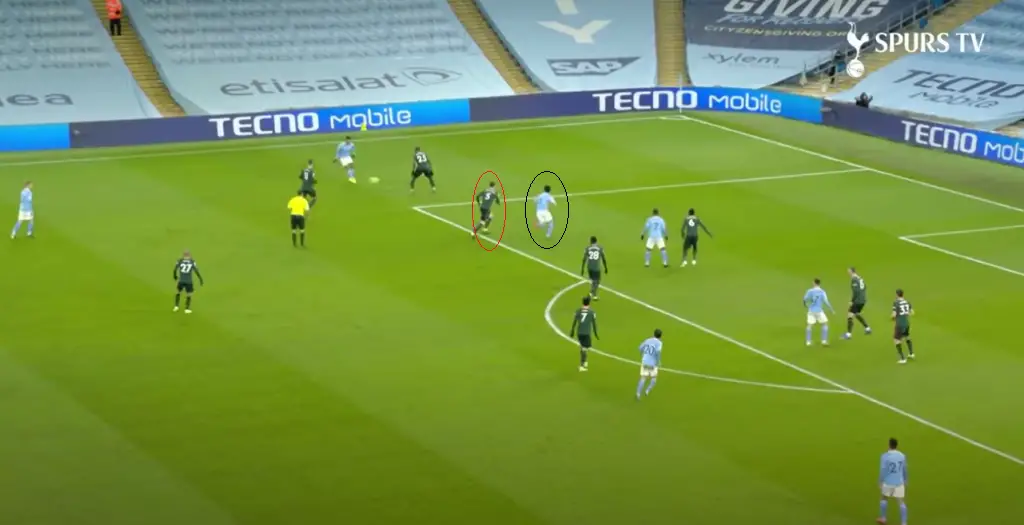
In the picture above, it is visible that Ilkay Gundogan made a run into the box from midfield. Manchester City lined up in a 4-1-4-1, which gave the midfielders ahead of Rodri (Gundogan and Bernardo Silva) the liberty to drive into the box.
Hojbjerg, in the picture above, just loses the City midfielder for a second. But that was enough. The situation could have still been controlled from here, but a poor tackle brought him down for what Mourinho called a ‘modern penalty‘.
Tottenham fielded a tried and tested 4-2-3-1 formation with Tanguy Ndombele and Hojbjerg as the defensive midfielders. So this goal can be put down to the midfield switching off for a split second and Hojbjerg making a mistimed tackle.
But it wasn’t just a ‘split second’. It happened again. For the second goal, it was Gundogan again who made the run inside the box.
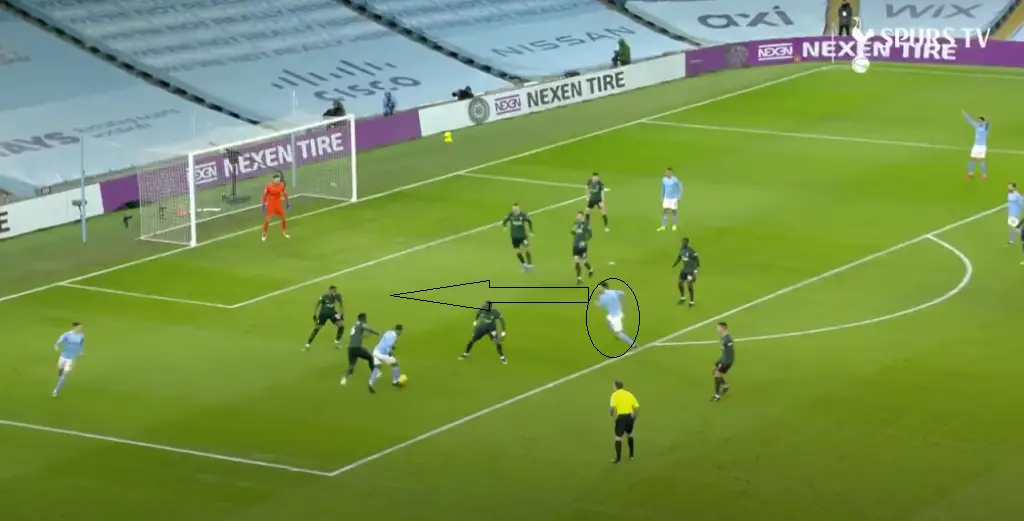
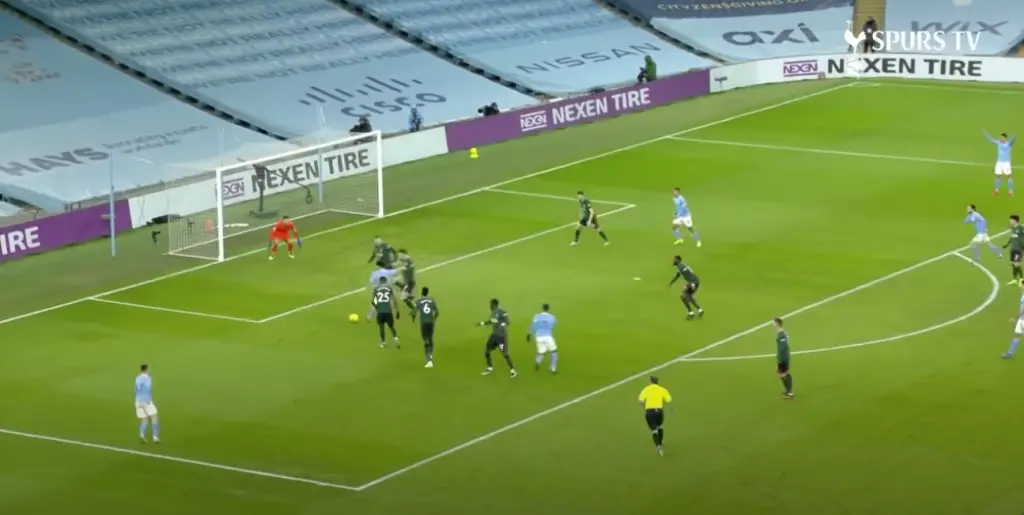
In the first photo of the two above, it can be seen that Gundogan was free to make a run inside the box. Spurs midfield has seemingly dozed off to his threat and by the time they get close to him (2nd picture), he gets the shot away and scores.
Yes, Lloris could have done better. But City’s central midfielders got behind the Spurs line of defence with much ease for the majority of the game.
For the third goal, the ‘front four’ and the ‘midfield two’ were occupying City players, looking to force Ederson to misplace a pass. This led to City players further up the pitch to make a run behind their defence.
It was Ilkay Gundogan again, who latched onto the long ball from Ederson. Tottenham probably wanted the Brazilian goalkeeper to clear it long, so that they can regain possession quickly to attack again. But it was also equally important for their players at the back to keep track of City’s attackers given their attackers were pressing high up the pitch.
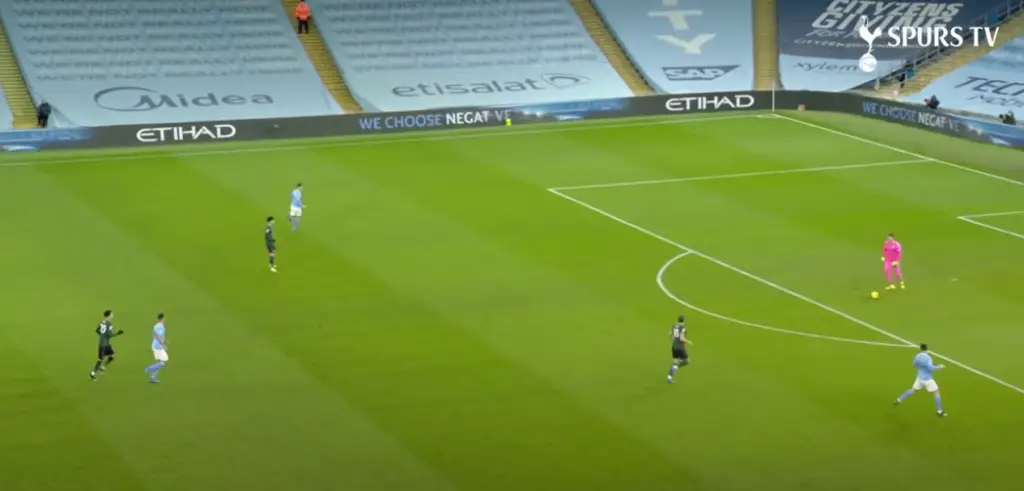
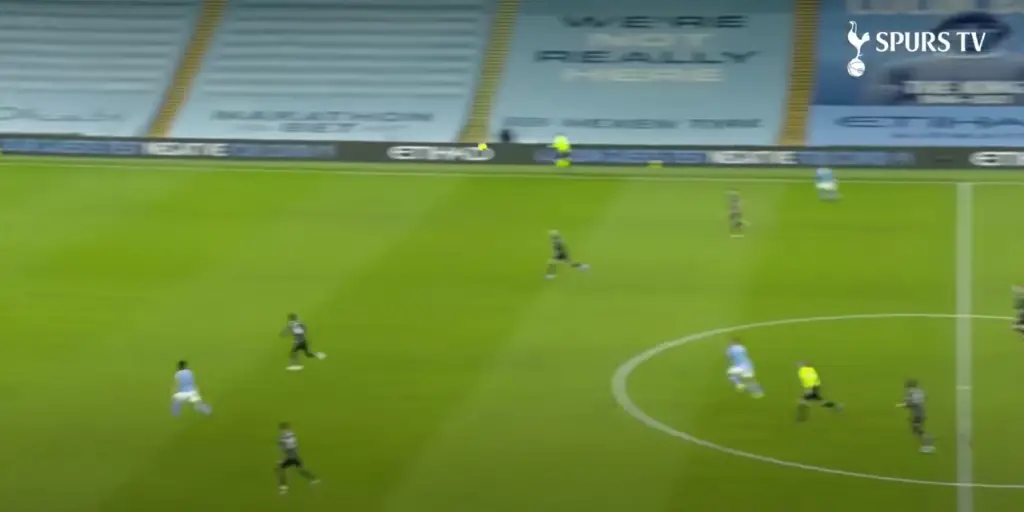
Their high line was easily bypassed with a long ball, and a mistake from Davinson Sanchez meant he was clear through on goal.
What to do then?
Tighten up in midfield and mark the runners. Gundogan was involved in all three goals and was not marked properly. That should be the primary instruction from Mourinho.
The formation was not faulty by itself. The two midfielders in front of the Spurs defence and the full-backs would offer good protection, but being aware and marking runs is equally important, especially when it is the league leaders you are playing against.
A major improvement that Mourinho could do is letting Harry Kane and Son Heung-min attack. Son was defending a lot that day and had very little freedom to attack. When not on the ball, the South Korean was spending time in his half of the pitch, helping out his defence.
This quote by Jamie Redknapp (h/t Football.london) probably sums up the attacking role (or the lack of it) of Son on the day.
“No pace going forward, I’m looking at Son who is doing more defending than attacking and this almost feels like the way they’re playing right now is a Jose masterclass and they are really struggling.”
Moreover, just look at Harry Kane’s heatmap below. The Englishman is one of the most potent goalscorers in Europe and has 13 league goals this season. But he had to drop very deep to get the ball. With the whole team generally playing on the backfoot, especially after conceding the first goal. He had no action inside City’s box.

Verdict
Hugo Lloris and Davinson Sanchez probably did not have a great game. The Colombian was at fault for the third goal while the Frenchman was not strong enough to keep out the first two.
Apart from being wary of individual errors, Mourinho should also allow more attacking freedom to Kane and Son, both of who are the club’s biggest attacking threats.
If their defensive midfielders can man-mark City’s midfielders better than they did in the Premier League encounter this month, they can also stop the menacing runs Gundogan made throughout the game.
While luck does factor in when playing cup finals, there is plenty to be learned from the loss for Mourinho. If Spurs can learn from it, then there is no reason why they cannot beat City at Wembley.
(All match screenshots and images taken from official match highlights posted by the Tottenham Hotspur YouTube account)

